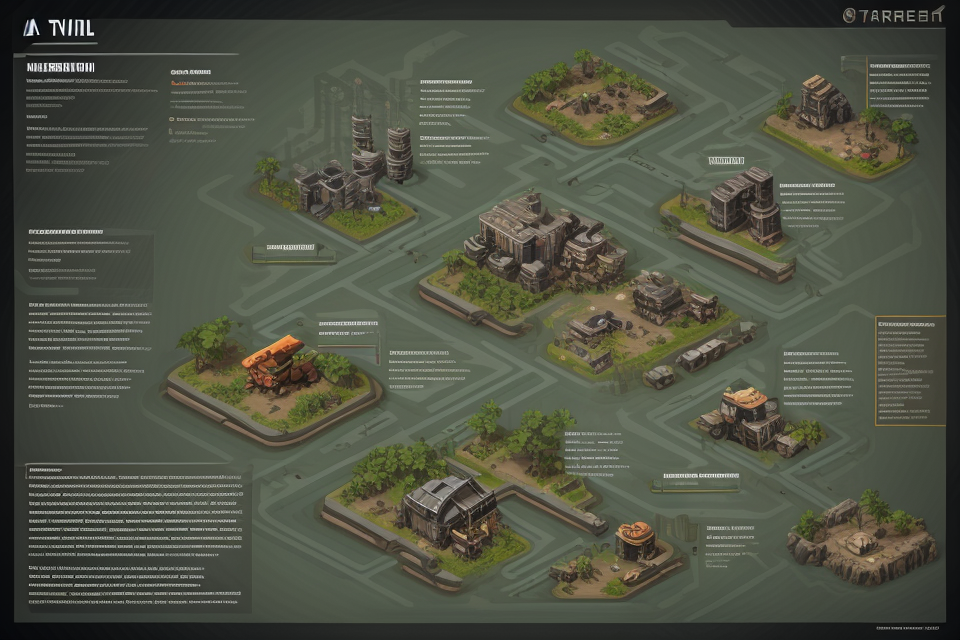Survival games have taken the gaming world by storm, captivating players with their immersive worlds and intense gameplay. But have you ever wondered how these games work? From crafting tools and gathering resources to fending off dangerous creatures and other players, survival games have a lot going on. In this comprehensive guide, we’ll dive into the mechanics of survival games, exploring the various systems and strategies that make these games so addictive. Whether you’re a seasoned survival game veteran or just starting out, this guide has something for everyone. So grab your backpack, sharpen your axe, and let’s get started!
What are Survival Games?
Definition and Overview
Survival games are a genre of video games that emphasize the struggle to survive in a hostile environment. These games typically challenge players to navigate harsh conditions, fend off dangerous creatures, and scavenge for resources in order to stay alive.
Types of Survival Games
There are several subgenres of survival games, each with their own unique gameplay mechanics and challenges. Some of the most popular types of survival games include:
- Open-world survival games: These games often feature vast, procedurally generated worlds that players must explore in order to find resources and build shelter. Examples include the popular game The Forest and the indie hit Don’t Starve.
- Survival horror games: These games focus on the player’s struggle to survive against hostile creatures or other supernatural threats. Examples include the classic game Resident Evil and the recent hit Alien: Isolation.
- City-building survival games: These games task players with constructing and maintaining a city while also managing resources and dealing with disasters. Examples include the popular game Cities: Skylines and the indie hit Frostpunk.
Key Features of Survival Games
Regardless of the specific type of survival game, there are several key features that are common across the genre:
- Resource management: Players must scavenge for resources such as food, water, and building materials in order to survive.
- Combat: Many survival games feature combat mechanics, whether it be against hostile creatures or other players.
- Crafting: Players often need to craft tools and weapons from gathered resources in order to survive.
- Exploration: Survival games often feature vast, open worlds that players must explore in order to find resources and build shelter.
- Progression: Players must progress through the game by unlocking new technologies, skills, and abilities.
Overall, survival games are a diverse and exciting genre that challenges players to think strategically and make tough decisions in order to survive. Whether it’s fending off zombies, exploring a post-apocalyptic world, or building a city from scratch, there’s a survival game out there for every type of player.
How Do Survival Games Work?
Game Mechanics and Systems
Resource Management
Resource management is a crucial aspect of survival games, as players must scavenge for essential resources such as food, water, and building materials to ensure their survival. Players must balance their needs and prioritize their actions accordingly. For instance, in the game The Forest, players must collect wood to build shelter, gather fruits and berries for sustenance, and hunt for food to survive. The scarcity of resources forces players to make strategic decisions and prioritize their actions to stay alive.
Combat and Enemies
Combat and enemies are essential elements of survival games, as players must defend themselves against hostile creatures or other players. Players must learn to assess threats, manage their inventory, and use various weapons and tactics to survive. In the game Rust, players must contend with other players who may try to kill them to acquire their resources. Players must also fend off hostile creatures such as bears and wolves that roam the game’s world.
Exploration and Navigation
Exploration and navigation are crucial aspects of survival games, as players must explore their environment to find resources, hidden treasures, and other useful items. Players must learn to navigate their surroundings, using maps, compasses, and other tools to locate points of interest. In the game Astroneer, players must explore planets to collect resources, build bases, and uncover the mysteries of the game’s world.
Crafting and Building
Crafting and building are essential mechanics in survival games, as players must use collected resources to create tools, weapons, and shelter. Players must learn to craft items such as weapons, armor, and furniture to improve their chances of survival. In the game Minecraft, players must gather resources, build structures, and defend themselves against hostile mobs to survive in a blocky, procedurally generated world.
In summary, game mechanics and systems are essential elements of survival games, as they govern the actions and interactions of players within the game world. Resource management, combat and enemies, exploration and navigation, and crafting and building are all critical mechanics that contribute to the challenge and excitement of survival games. Understanding these mechanics is essential for players to master the game and increase their chances of survival.
Player Interaction and Multiplayer
Cooperation and Competition
In survival games, players must cooperate and compete simultaneously. The primary objective is to survive as long as possible, but players also compete for resources and positions of power. Cooperation is crucial for achieving shared goals, such as building shelters or fending off enemies. However, competition can arise when players vie for limited resources or try to undermine each other’s efforts.
Communication and Social Dynamics
Effective communication is essential in survival games, as players must coordinate their actions and share information to succeed. However, communication can also be a double-edged sword, as it can reveal a player’s location or intentions to others. Social dynamics also play a significant role in survival games, as players must navigate complex relationships and alliances to survive. These dynamics can be shaped by factors such as trust, loyalty, and personal goals.
Understanding the Psychology of Survival Games
Motivations and Goals
Survival Instincts
Survival games are designed to tap into the basic human instinct to survive. Players are often placed in hostile environments where they must scavenge for resources, fend off enemies, and make difficult decisions to stay alive. This primal urge to survive serves as the foundation for the game’s motivations and goals.
Progression and Achievement
Another key aspect of survival games is the drive to progress and achieve. Players are often rewarded with new abilities, equipment, and opportunities as they advance through the game. This sense of accomplishment and the desire to reach new milestones keeps players engaged and motivated.
Social and Competitive Aspects
Survival games also tap into the human need for social interaction and competition. Many games feature multiplayer modes where players can form alliances, compete against each other, and work together to achieve common goals. This social and competitive element adds an extra layer of motivation and challenge for players.
Challenges and Stressors
Danger and Threats
Survival games often present players with various forms of danger and threats, such as hostile creatures, harsh weather conditions, and treacherous terrain. These challenges are designed to create a sense of urgency and to encourage players to prioritize their actions accordingly.
Resource Scarcity and Management
Resource scarcity is a common stressor in survival games, as players must scavenge for food, water, and other essential items to stay alive. This aspect of the game creates a sense of urgency and encourages players to make strategic decisions about how to allocate their resources.
Time Pressure and Decision Making
Time pressure is another significant stressor in survival games, as players are often on a tight schedule to complete objectives or find safety before their time runs out. This element of the game adds an extra layer of tension and forces players to make quick decisions that can have significant consequences.
Survival Game Design Principles and Best Practices
Balancing Gameplay Elements
Challenge and Accessibility
Balancing gameplay elements is crucial in survival games, as it ensures that players are challenged without becoming frustrated or overwhelmed. One key aspect of challenge is the difficulty curve, which should increase gradually as players progress through the game. This allows players to learn and adapt to new mechanics and gameplay elements without becoming too overwhelmed.
Another important aspect of challenge is the use of risk and reward. Survival games should offer players meaningful choices that impact the outcome of the game, and these choices should be balanced in terms of the risks and rewards they offer. For example, a player may choose to venture into a dangerous area in search of valuable resources, but they also risk encountering dangerous enemies.
Pacing and Progression
Pacing and progression are also essential aspects of balancing gameplay elements in survival games. Pacing refers to the flow of gameplay, and should be carefully managed to ensure that players are engaged throughout the game. This can be achieved through a variety of means, such as introducing new gameplay elements at regular intervals, or varying the difficulty of certain sections of the game.
Progression refers to the way in which players progress through the game, and should be designed to keep players engaged and motivated. This can be achieved through a variety of means, such as unlocking new abilities or items as players progress, or by introducing new challenges and enemies that require players to adapt their strategies.
Replayability and Variety
Replayability and variety are also important aspects of balancing gameplay elements in survival games. Replayability refers to the ability of players to play the game multiple times, and should be achieved through a variety of means, such as randomly generated levels or the ability to make different choices that impact the outcome of the game.
Variety refers to the variety of gameplay elements and experiences that players encounter throughout the game. This can be achieved through a variety of means, such as introducing new environments or enemies, or by offering players a range of different gameplay mechanics to master.
Overall, balancing gameplay elements is crucial in survival games, as it ensures that players are challenged without becoming frustrated or overwhelmed. By carefully managing the difficulty curve, using risk and reward, pacing and progression, and promoting replayability and variety, game designers can create engaging and enjoyable survival game experiences.
Engaging Narratives and World Building
Storytelling and Lore
- Incorporating rich storytelling elements
- Crafting compelling lore
- Balancing intrigue and player discovery
Immersion and Atmosphere
- Establishing a believable world
- Atmospheric sound design
- Environmental storytelling
In the realm of survival games, engaging narratives and immersive world-building are crucial components for player investment and enjoyment. This section delves into the strategies employed by game developers to create captivating stories and foster a sense of immersion within their virtual environments.
Storytelling and Lore
A captivating narrative can greatly enhance a player’s experience in a survival game. Developers employ various techniques to weave intriguing stories and lore into their games, enticing players to explore and uncover the mysteries hidden within. Some of these methods include:
- Incorporating rich storytelling elements: Through the use of characters, dialogue, and cutscenes, developers can immerse players in a compelling narrative that unfolds as they progress through the game. By creating dynamic and engaging characters, developers can encourage players to form emotional connections, making the game world feel more alive and meaningful.
- Crafting compelling lore: Survival games often feature ancient histories, mystical elements, or secret organizations that provide depth and intrigue to the game world. Developers can reveal this lore through discoverable notes, artifacts, and environmental storytelling, enticing players to delve deeper into the game’s history and mythology.
- Balancing intrigue and player discovery: Striking the right balance between giving players enough information to feel engaged without overwhelming them with exposition is essential. Developers can achieve this by providing subtle hints, riddles, and puzzles for players to uncover, encouraging exploration and discovery while still allowing players to piece together the game’s story at their own pace.
Immersion and Atmosphere
A well-designed game world can transport players into a new reality, making them feel as if they are truly part of the experience. Developers employ various techniques to create immersive atmospheres, including:
- Establishing a believable world: A game’s setting should be grounded in reality, with rules and systems that players can understand and relate to. Developers can create a sense of believability by adhering to established laws of physics, ecology, and sociology, while still allowing for fantastical elements that add to the game’s intrigue.
- Atmospheric sound design: Sound plays a crucial role in creating an immersive experience. Developers can use ambient noise, music, and effects to set the tone and mood of a scene, creating tension, wonder, or fear as appropriate.
- Environmental storytelling: The game world should be designed to tell a story through its environment. Developers can achieve this by creating landscapes that reflect the game’s history, culture, and events, and by using visual cues such as architecture, foliage, and wildlife to hint at the game’s lore and backstory.
By focusing on engaging narratives and immersive world-building, survival game developers can create experiences that captivate players and keep them coming back for more.
Technical Considerations and Optimization
Performance and Frame Rate
One of the most critical factors in a survival game’s success is its performance. A smooth and responsive gameplay experience is essential for players to fully immerse themselves in the game world and make strategic decisions. Therefore, it is crucial to optimize the game’s performance to ensure that it runs smoothly on a wide range of hardware configurations.
Here are some tips for optimizing performance and frame rate in a survival game:
- Use efficient programming techniques: Programmers can use techniques such as batching, level streaming, and occlusion culling to reduce the number of draw calls and improve rendering performance.
- Optimize resource usage: Developers can optimize resource usage by reducing the number of active objects in the game world, minimizing the number of dynamic lighting sources, and reducing the size of texture and audio files.
- Use efficient asset management: Asset management is crucial for optimizing performance. Developers can use tools such as texture atlases and sprite sheets to reduce the number of draw calls and improve rendering performance.
- Optimize network communication: In multiplayer survival games, network communication can significantly impact performance. Developers can optimize network communication by reducing the amount of data sent over the network, using compression algorithms, and minimizing latency.
User Interface and Controls
A well-designed user interface and controls are essential for a survival game’s success. A user-friendly interface can improve the player’s experience and make it easier for them to understand the game mechanics. Therefore, it is crucial to design an intuitive and accessible user interface that provides players with all the necessary information without overwhelming them.
Here are some tips for designing an effective user interface and controls in a survival game:
- Use clear and concise labels: Labels should be easy to read and understand, and they should provide players with all the necessary information without being overly verbose.
- Group related information: Grouping related information together can help players quickly find the information they need. For example, all the controls related to movement should be grouped together.
- Use consistent design patterns: Consistent design patterns can help players quickly understand how to use the interface. For example, using the same icon for inventory management throughout the game can help players easily identify it.
- Provide feedback: Feedback is essential for helping players understand what is happening in the game world. Developers can use visual and audio feedback to inform players of important events, such as low health or depleted resources.
By following these best practices, developers can create a survival game that is both engaging and optimized for performance. A well-designed user interface and controls can help players quickly understand the game mechanics and immerse themselves in the game world.
Analysis of Popular Survival Games
Minecraft
Core Mechanics and Gameplay
Minecraft, developed by Mojang Studios, is a sandbox survival game that has taken the world by storm. The game is known for its blocky 3D graphics, endless procedurally generated worlds, and infinite possibilities for creativity and exploration.
The core mechanics of Minecraft revolve around survival, exploration, and building. Players must gather resources such as wood, stone, and iron to build shelter, tools, and weapons. They must also find food to sustain themselves and fight off hostile mobs such as zombies, skeletons, and creepers.
The gameplay is open-ended, allowing players to choose their own path and goals. They can focus on survival, building grand structures, or exploring the depths of the world to discover hidden treasures and secrets.
Player Creativity and Customization
One of the defining features of Minecraft is its emphasis on player creativity and customization. Players can build anything from simple shelters to elaborate castles, cities, and even entire theme parks. The game’s blocky graphics and simple controls make it easy for players to express their creativity and bring their wildest dreams to life.
In addition to building, players can also customize their characters with different skins, outfits, and accessories. This adds a layer of personalization to the game and allows players to express their individuality.
Community and Modding
Minecraft has a large and active community of players who share their creations and ideas with each other. The game’s forums and social media channels are filled with fan-made content, such as mods, skins, and resource packs. These mods add new features and gameplay mechanics, allowing players to customize the game to their liking.
The game’s modding community is particularly impressive, with thousands of mods available for download. These mods range from small tweaks to the game’s mechanics to full-fledged expansion packs that add new biomes, creatures, and gameplay mechanics. The modding community has kept the game fresh and exciting for players even years after its initial release.
Rust
PvP and Survival Mechanics
Rust is a popular survival game that is known for its harsh and unforgiving environment. Players must scavenge for resources, build shelter, and fend off other players in order to survive. The game’s PvP (player versus player) mechanics are a key aspect of gameplay, as players must not only contend with the environment but also with other players who are trying to do the same.
One of the key mechanics of Rust is the need to constantly gather resources in order to survive. This includes gathering wood, metal, and other materials that can be used to build structures and craft weapons. Players must also hunt for food and water in order to stay alive, adding an additional layer of challenge to the game.
The survival mechanics in Rust are closely tied to the game’s PvP elements, as players must not only contend with the environment but also with other players who are trying to do the same. This leads to a high level of competition and tension, as players must constantly be on the lookout for other players who may be trying to take their resources or kill them.
Progression and Sandbox Elements
In addition to its PvP and survival mechanics, Rust also features a sandbox-style gameplay experience. Players are free to explore the game’s world, build structures, and experiment with different strategies and approaches. This sandbox-style gameplay allows players to shape the game world to their liking, creating a unique and personalized experience.
As players progress through the game, they will unlock new tools and weapons that allow them to survive in harsher environments and take on tougher challenges. This progression system adds an additional layer of depth to the game, as players must constantly adapt and evolve in order to survive.
Overall, Rust is a complex and challenging survival game that offers a unique and immersive gameplay experience. Its combination of PvP and survival mechanics, along with its sandbox-style gameplay, make it a standout title in the survival game genre.
Don’t Starve Together
Don’t Starve Together, developed by Klei Entertainment, is a multiplayer survival game that emphasizes both cooperation and competition among players. In this game, players must work together to gather resources, build shelter, and fend off hostile creatures in order to survive as long as possible. However, the game also includes elements of competition, as players must also compete with each other for limited resources and seek to outlast one another.
Hunger and Health Mechanics
Hunger and health mechanics play a crucial role in Don’t Starve Together. Players must constantly monitor their characters’ hunger levels and take steps to keep them fed. Eating food will satisfy hunger, but it will also deplete the character’s health. This creates a delicate balance between staying alive and maintaining a healthy diet. Additionally, characters will suffer from various maladies, such as starvation, dehydration, and hypothermia, which can have serious consequences if left untreated.
Seasonal Events and Content
Don’t Starve Together features seasonal events and content that add variety and challenge to the game. These events often introduce new creatures, items, and challenges that players must contend with in order to survive. For example, the game’s winter season brings freezing temperatures, blizzards, and ice-based enemies, while the summer season brings heat waves, fire-based enemies, and new ways to cool down. These events provide a dynamic and ever-changing environment that keeps players on their toes and adds to the overall replayability of the game.
Terraria
Action and Exploration
In Terraria, players must explore a procedurally generated world, gathering resources and battling enemies to progress through the game. The game’s world is vast and filled with different biomes, each with its own unique features and challenges. Players must use a combination of combat and exploration skills to navigate the world and overcome obstacles.
One of the key features of Terraria’s action and exploration mechanics is the day and night cycle. During the day, players can explore the world and gather resources, while at night they must fend off waves of monsters that emerge from the darkness. This adds an extra layer of strategy to the game, as players must carefully balance their time between exploration and defense.
Building and Crafting
Terraria’s building and crafting mechanics are a core part of the gameplay experience. Players must gather resources and use them to craft weapons, armor, and other items. The game features a deep crafting system, with hundreds of different items to create.
The building mechanics in Terraria are also very robust. Players can construct a wide variety of structures, from simple homes to elaborate castles. The game features a flexible building system that allows players to create structures of all shapes and sizes.
Boss Battles and Progression
Terraria’s boss battles are a major part of the game’s progression system. Players must defeat powerful bosses to progress through the game and unlock new content. These boss battles are challenging and require careful planning and preparation.
In addition to boss battles, Terraria also features a variety of other progression systems. Players can explore the world to unlock new biomes, discover new resources, and unlock new crafting recipes. The game also features a wide variety of NPCs that players can interact with, each offering unique items and services.
Overall, Terraria’s mechanics are well-designed and offer a rich and engaging gameplay experience. The game’s combination of action, exploration, building, crafting, and progression systems make it a standout in the survival game genre.
Future Trends and Developments in Survival Games
VR and AR Integration
Immersion and Interaction
One of the most significant developments in the survival game genre is the integration of virtual reality (VR) and augmented reality (AR) technologies. These technologies offer the potential to create unparalleled levels of immersion and interaction for players, making the game world feel more real and tangible than ever before.
With VR and AR integration, players can experience survival games in a whole new way. For example, players can use VR headsets to fully immerse themselves in the game world, interacting with their environment and other players in real-time. This level of immersion can lead to a more intense and engaging gaming experience, as players feel like they are truly a part of the game world.
AR technology can also be used to enhance the game world in new and exciting ways. For example, players can use their smartphones or tablets to view the game world through an AR app, allowing them to see virtual elements overlayed on the real world. This can create a unique and innovative gameplay experience, as players must navigate both the real world and the virtual world simultaneously.
Technical Challenges and Opportunities
While the integration of VR and AR technologies offers many exciting opportunities for survival games, it also presents a number of technical challenges. For example, VR and AR technologies require a significant amount of processing power and memory, which can be a challenge for many gaming systems. Additionally, VR and AR headsets can be expensive and may not be accessible to all players.
Despite these challenges, the integration of VR and AR technologies represents a significant opportunity for the survival game genre. By offering new and innovative ways to experience the game world, these technologies can help to keep the genre fresh and exciting for players. Additionally, as the technology continues to evolve and improve, it is likely that we will see even more exciting developments in the future.
Innovations in Multiplayer Experiences
Dynamic Events and World Changes
One of the key areas where survival games are constantly evolving is in their multiplayer experiences. Developers are continually finding new ways to make these experiences more dynamic and engaging for players. One of the ways they are achieving this is through the use of dynamic events and world changes.
Dynamic events are those that occur in real-time and can affect the game world in a variety of ways. For example, a forest fire might spread across the map, changing the landscape and creating new challenges for players to overcome. These events can be triggered by player actions or by the game itself, and they add a sense of unpredictability and excitement to the game.
World changes are similar to dynamic events, but they are more long-term in nature. For example, a volcano might erupt, permanently altering the landscape and creating new areas for players to explore. These changes can also be triggered by player actions, such as mining for resources in a particular area, or by the game itself, such as the natural progression of time.
Both dynamic events and world changes add a sense of realism to the game world and keep players on their toes, always on the lookout for the next challenge or opportunity.
Player-Driven Content and Storytelling
Another trend in survival games is the integration of player-driven content and storytelling. This allows players to create their own stories and experiences within the game world, adding a new level of depth and interactivity to the game.
One way this is achieved is through the use of player-generated content, such as building designs, maps, and game modes. Players can share their creations with others, and the best ones can even be incorporated into the game itself, becoming part of the official content.
Another way player-driven content and storytelling is integrated is through the use of player-vs-player (PvP) gameplay. Players can form their own factions and compete against each other for resources and territory, creating their own stories and legends within the game world.
These innovations in multiplayer experiences are just a few examples of the ways survival games are constantly evolving and improving. By incorporating new technologies and gameplay mechanics, developers are able to create more immersive and engaging experiences for players, ensuring that the genre remains fresh and exciting for years to come.
Sustainable and Environmentally-Conscious Game Design
Eco-Friendly Mechanics and Messaging
In recent years, there has been a growing trend in the gaming industry towards sustainability and environmental consciousness. Many game developers are now incorporating eco-friendly mechanics and messaging into their games, as a way to raise awareness about environmental issues and encourage players to adopt more sustainable lifestyles.
One example of this is the popular game “Don’t Starve,” which features a survival mode that requires players to gather resources and build shelter while also managing their hunger and thirst. The game includes a “Eco-Friendly” mode, which encourages players to reduce their environmental impact by using renewable resources and avoiding waste.
Another example is the game “Green Hell,” which is set in the Amazon rainforest and challenges players to survive in a harsh and unforgiving environment. The game includes realistic ecological systems, such as plant growth and decomposition, and encourages players to conserve resources and minimize their impact on the environment.
Education and Awareness
In addition to incorporating eco-friendly mechanics and messaging into their games, many developers are also using games as a tool for education and awareness. For example, the game “Racing Extinction” uses a racing game format to educate players about the extinction crisis and the impact of human activity on the environment.
Other games, such as “WolfQuest” and “ElkHerd,” are being used in classrooms and educational settings to teach students about ecology and wildlife conservation. These games provide an engaging and interactive way for students to learn about the natural world and the importance of sustainability.
Overall, the trend towards sustainable and environmentally-conscious game design is a positive development for the gaming industry and for society as a whole. By incorporating eco-friendly mechanics and messaging into their games, and using games as a tool for education and awareness, developers can help to promote sustainability and environmental awareness among players of all ages.
Key Takeaways and Final Thoughts
Importance of Understanding Game Mechanics
In order to truly appreciate the future trends and developments in survival games, it is essential to first understand the fundamental mechanics that drive these games. By studying the intricacies of survival game mechanics, designers and players alike can gain valuable insights into how these games function, and how they can be improved. This knowledge is crucial for anyone looking to stay ahead of the curve in the world of survival games.
Impact on Player Experience and Engagement
Survival games have a unique ability to captivate players, drawing them into immersive worlds where every decision could mean the difference between life and death. By understanding the mechanics that drive these games, designers can create even more engaging experiences that keep players coming back for more. Whether it’s through innovative new gameplay mechanics or improved storytelling techniques, the future of survival games is sure to be an exciting one.
Future Directions for Research and Development
As survival games continue to evolve, there will be an increasing need for research and development to push the genre forward. Whether it’s through the creation of new mechanics, the exploration of new themes, or the use of cutting-edge technology, the future of survival games is limited only by our imaginations. By investing in research and development, designers can ensure that their games remain relevant and engaging for years to come.
FAQs
1. What are survival games?
Survival games are a type of video game that focus on the player’s ability to survive in a hostile environment. These games often involve crafting tools and weapons, scavenging for resources, and facing dangerous creatures and obstacles. The ultimate goal is to survive as long as possible in the harsh conditions.
2. How do survival games work?
Survival games typically involve a combination of exploration, resource management, and survival mechanics. Players must gather resources, craft tools and weapons, and build shelter to survive in the game world. They must also manage their hunger, thirst, and health, and protect themselves from dangerous creatures and environmental hazards.
3. What are some popular survival games?
Some popular survival games include Minecraft, The Forest, Rust, Don’t Starve, and Subnautica. Each game has its own unique mechanics and gameplay elements, but all share the core goal of survival in a hostile environment.
4. What are the basic mechanics of survival games?
The basic mechanics of survival games include resource gathering, crafting, hunger and thirst management, health management, and protection from danger. Players must gather resources such as wood, food, and water to survive, and use these resources to craft tools and weapons. They must also manage their hunger and thirst levels, and protect themselves from dangerous creatures and environmental hazards.
5. How do players progress in survival games?
Players progress in survival games by gathering resources, crafting tools and weapons, and building shelter. They must also explore the game world to find new resources and locations, and use their skills and knowledge to overcome challenges and obstacles. As players progress, they may unlock new crafting recipes and abilities, and face increasingly difficult challenges.
6. What are some tips for playing survival games?
Some tips for playing survival games include learning how to gather resources efficiently, prioritizing hunger and thirst management, building a strong shelter, and being prepared for dangerous encounters. It’s also important to explore the game world and gather resources to improve your chances of survival.
7. Are survival games suitable for all ages?
Survival games can be suitable for all ages, but some games may contain mature content such as violence and language. It’s important to check the game’s rating and content before allowing children to play. Additionally, some survival games may be too challenging for younger players, so it’s important to consider their skill level and experience when choosing a game.









